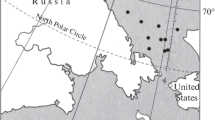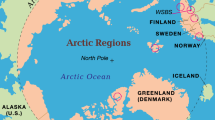Abstract
Fifty samples of bottom sediments were taken in 2016–2017 in the Kandalaksha Bay of the White Sea from the depth of 1.5–15.0 m, and 1419 colonies of mycelial fungi were obtained. Based on morphological and cultural features, a total of 136 morphotypes were classified, and 81 of these were identified down to the species level. Thirteen species were new to the White Sea. The most common species were Tolypocladium cylindrosporum, Penicillium chrysogenum, Tolypocladium inflatum, Penicillium glabrum, and the anamorph of Pseudogymnoascus pannorum. The dominance of Ascomycota was a common characteristic of the mycobiota due to the anamorphic species, and the class Sordariomycetes was the most diverse and numerous group. Assessment of species richness using a cumulative curve and the calculation of the expected total number of species adjusted using the Chao2 method evidenced that approximately 81% of the species diversity was found within the study. The ordination of samples by the nMDS method with the ANOSIM test showed the high importance of combining the samples into groups based on the year of sampling and type of sediment as well as the year of sampling and type of ecotope. Therefore, the type of sediment associated with the type of coast and the presence of fresh runoff were the most important factors for the formation of mycobiota. Moreover, the communities of mycelial fungi change from year to year in the studied bottom sediments.

Similar content being viewed by others
REFERENCES
Bongiorni, L., Thraustochytrids, a neglected component of organic matter decomposition and food webs in marine sediments, in Biology of Marine Fungi, Raghukumar, C., Ed., Berlin–Heidelberg: Springer, 2012, pp. 1–15.
Kohlmeyer, J. and Kohlmeyer, E., Marine Mycology, the Higher Fungi, New York–San Francisco–London: Academic Press, 1979.
Khudyakova, Yu.V., Pivkin, M.V., Kuznetsova, T.A., and Svetashev, V.I., Fungi in sediments of the Sea of Japan and their biologically active metabolites, Microbiology, 2000, vol. 69, no. 5, pp. 608–611.
Damare, S., Raghukumar, C., and Raghukumar, S., Fungi in deep-sea sediments of the Central Indian Basin, Deep Sea Res. Part I Oceanogr. Res. Pap., 2006, vol. 53, pp. 14–27.
Bubnova, E.N., Fungi of bottom soils of the Kandalaksha Bay of the White Sea, Mikol. Fitopatol., 2009, vol. 43, no. 4, pp. 4–11.
Bubnova, E.N., Fungal diversity in bottom sediments of the Kara Sea, Bot. Mar., 2010, vol. 53, no. 6, pp. 595–600.
Nagano, Y. and Nagahama, T., Cultured and uncultured fungal diversity in deep-sea environments, in Biology of Marine Fungi, Raghukumar, C., Ed., Berlin–Heidelberg: Springer, 2012, pp. 173–189.
Bubnova, E.N. and Nikitin, D.A., Fungi in bottom sediments of the Barents and Kara Seas, Russ. J. Mar. Biol., 2017, vol. 43, no. 5, pp. 400–406.
Bubnova, E.N. and Konovalova, O.P., Diversity of filamentous fungi in the littoral and sublittoral grounds of the Barents Sea (environs of the village of Dalnie Zelentsy), Mikol. Fitopatol., 2018, vol. 52, no. 5, pp. 320–328.
Khusnullina, A.I., Bilanenko, E.N., and Kurakov, A.V., Microscopic fungi of White Sea sediments, Contemp. Probl. Ecol., 2018, vol. 11, no. 5, pp. 503–513.
Hagestad, O.C., Andersen, J.H., Altemark, B., Hansen, E., and Rämä, T., Cultivable marine fungi from the Arctic Archipelago of Svalbard and their antibacterial activity, Mycologia, 2019, vol. 10, no. 4. https://doi.org/10.1080/21501203.2019.1708492
Luo, Y., Xu, W., Luo, Z., and Pang, K.-L., Diversity and temperature adaptability of cultivable fungi in marina sediments from the Chukchi Sea, Bot. Mar., 2020, vol. 63, no. 2, pp. 197–207.
Chikina, M.V., Basin, A.B., Mokievskiy, V.O., Kucheruk, N.V., Kozlovskiy, V.V., and Shabalin, N.V., Spatial structure of macro- and meiobenthic communities in a homogeneous environment (on the example of the Pechora Sea), Oceanology, 2019, vol. 59, no. 3, pp. 367–373.
Clarke, K.R. and Warwick, R.M., Change in Marine Communities: An Approach to Statistical Analysis and Interpretation, Plymouth: Primer-E Ltd, 2001, 2nd ed.
Bubnova, E.N., Diversity of the microscopic fungi in the littoral sands of the White Sea, Moscow Univ. Biol. Sci. Bull., 2017, vol. 72, pp. 121–127.
Bubnova, E.N., Grum-Grzhimaylo, O.A., Konovalova, O.P., and Marfenina, O.E., Fifty years of mycological studies at the White Sea Biological Station of Moscow State University: Challenges, results, and outlook, Moscow Univ. Biol. Sci. Bull., 2014, vol. 69, no. 1, pp. 23–39.
Jones, E.B.G., Suetrong, S., Sakayaroj, J., Bahkali, A.H., Abdel-Wahab, M.A., Boekhout, T., and Pang, K.L., Classification of marine Ascomycota, Basidiomycota, Blastocladiomycota and Chytridiomycota, Fungal Diversity, 2015, vol. 73, no. 1, pp. 1–72.
Rämä, T., Hassett, B.T., and Bubnova, E., Arctic marine fungi: From filaments and flagella to operation taxonomic units and beyond, Bot. Mar., 2017, vol. 60, no. 4, pp. 433–452.
Grum-Grzhimaylo, O.A., Debets, J.M., and Bilanenko, E.N., Mosaic structure of the fungal community in the Kislo-Sladkoe Lake that is detaching from the White Sea, Polar Biol., 2018, vol. 41, no. 10, pp. 2075–2089.
ACKNOWLEDGMENTS
The authors express their gratitude to the scuba-diving team of WSBS for help in organizing the collection of research materials and to M.V. Chikina (Shirshov Institute of Oceanology, Russian Academy of Sciences) for a discussion of the study results.
Funding
The study was carried out with partial financial support of the Russian Foundation for Basic Research (grant no. 20-04-00882a, processing and analysis of primary data on species composition) and the grant of Moscow State University for supporting the leading scientific schools of Moscow State University “ ‘Noah’s Ark’ Living Systems Depository, National Depositary Bank of Living Systems” in the framework of the Development Program of Moscow State University (statistical processing).
Author information
Authors and Affiliations
Corresponding author
Ethics declarations
Statement on the welfare of animals. This article does not contain any studies involving animals or human participants performed by any of the authors.
Conflict of interest. The authors declare that they have no conflict of interest.
Additional information
Translated by D. Martynova
About this article
Cite this article
Bubnova, E.N., Grum-Grzhimaylo, O.A. & Kozlovsky, V.V. Composition and Structure of the Community of Mycelial Fungi in the Bottom Sediments of the White Sea. Moscow Univ. Biol.Sci. Bull. 75, 153–158 (2020). https://doi.org/10.3103/S0096392520030037
Received:
Revised:
Accepted:
Published:
Issue Date:
DOI: https://doi.org/10.3103/S0096392520030037




